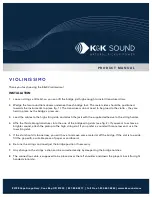
Remote Control
R&S
®
ZNC
347
User Manual 1173.9557.02 ─ 13
The command recognition detects syntax errors in the commands and transfers them to
the status reporting system. The rest of a command line after a syntax error is still exe-
cuted, if possible. After the syntax check, the range of the numerical parameters is
checked, if required.
If the command recognition detects a delimiter or a
DCL
, it also requests the data set to
perform the necessary instrument hardware settings. Subsequently it is immediately pre-
pared to process further commands. This means that new commands can already be
serviced while the hardware is still being set (overlapping execution).
5.4.3 Data Base and Instrument Hardware
The expression instrument hardware denotes the part of the instrument fulfilling the actual
instrument function – signal generation, measurement etc. The controller is not included.
The data base manages all the parameters and associated settings required for the
instrument hardware.
Setting commands lead to an alteration in the data set. The data set management enters
the new values (e.g. frequency) into the data set, however, it only passes them on to the
hardware when requested by the command recognition. This can only occur at the end
of a command line, therefore the order of the setting commands in the command line is
not relevant.
The commands are only checked for their compatibility among each other and with the
instrument hardware immediately before they are transmitted to the instrument hardware.
If the instrument detects that execution is not possible, an execution error is signalled to
the status reporting system. All alterations of the data set are cancelled, the instrument
hardware is not reset. Due to the delayed checking and hardware setting, however,
impermissible instrument states can be set for a short period of time within one command
line without this leading to an error message (example: simultaneous activation of a fre-
quency and a power sweep). At the end of the command line, however, a permissible
instrument state must have been reached again.
Before passing on the data to the hardware, the settling bit in the
STATus:OPERation
register is set (see
chapter 5.5.3.4, "STATus:OPERation"
executes the settings and resets the bit again as soon as the new state has settled. This
fact can be used to synchronize command servicing.
Queries induce the data set management to send the desired data to the output unit.
5.4.4 Status Reporting System
The status reporting system collects information on the instrument state and makes it
available to the output unit on request. The exact structure and function are described in
chapter 5.5, "Status Reporting System"
Command Processing
















































